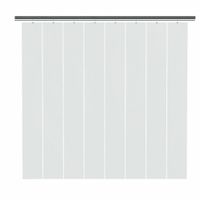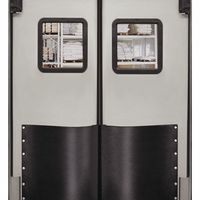Call +(254) 703 030 000 / 751 483 999 / 721 704 777
Frequently Asked Questions
What are the benefits of using strip doors in warehouses?
Strip doors, also known as strip curtains, offer several benefits in warehouse environments:
1. **Energy Efficiency**: Strip doors help maintain temperature control by minimizing the exchange of air between different areas. This is particularly beneficial in temperature-sensitive environments like cold storage, reducing energy costs associated with heating or cooling.
2. **Cost-Effective**: They are relatively inexpensive to install and maintain compared to solid doors. Their durability and low maintenance requirements contribute to long-term cost savings.
3. **Improved Workflow**: Strip doors allow for easy passage of personnel and equipment without the need to open and close doors, enhancing operational efficiency and reducing bottlenecks in busy areas.
4. **Safety**: They provide a clear line of sight, reducing the risk of accidents by allowing workers to see through to the other side. This is crucial in high-traffic areas where forklifts and other machinery operate.
5. **Contamination Control**: Strip doors help in controlling dust, debris, and pests, maintaining a cleaner environment. This is essential in warehouses handling food products or sensitive materials.
6. **Noise Reduction**: They can help dampen noise levels between different sections of a warehouse, contributing to a more comfortable working environment.
7. **Flexibility**: Strip doors can be easily customized to fit various sizes and configurations, making them suitable for a wide range of applications within a warehouse.
8. **Durability**: Made from robust materials like PVC, strip doors are resistant to wear and tear, ensuring longevity even in high-traffic areas.
9. **Compliance**: In some industries, strip doors help meet regulatory requirements for hygiene and safety, particularly in food processing and pharmaceutical sectors.
Overall, strip doors enhance operational efficiency, safety, and environmental control in warehouses, making them a valuable asset in industrial settings.
How do swinging doors improve efficiency in commercial kitchens?
Swinging doors enhance efficiency in commercial kitchens by facilitating smooth and rapid movement between different areas, such as the kitchen and dining room. These doors allow staff to pass through without using their hands, which is crucial when carrying trays, dishes, or other items. This hands-free operation reduces the risk of spills and accidents, maintaining a clean and safe environment.
The bidirectional nature of swinging doors enables quick access and exit, minimizing bottlenecks and congestion during peak hours. This fluid movement is essential for maintaining the pace of service, ensuring that food is delivered promptly and at the right temperature. Additionally, swinging doors help in maintaining temperature zones by quickly closing after passage, which is vital for food safety and energy efficiency.
Swinging doors also contribute to noise reduction, as they close automatically, preventing the clatter of dishes and kitchen sounds from reaching the dining area. This creates a more pleasant dining experience for customers. Furthermore, these doors often have windows or transparent panels, allowing staff to see through and avoid collisions, enhancing safety and coordination.
In terms of hygiene, swinging doors reduce the need for frequent contact, lowering the risk of cross-contamination. They are typically easy to clean and maintain, which is important in a high-turnover environment like a commercial kitchen. Overall, swinging doors streamline operations, improve safety, and enhance the dining experience, making them a valuable asset in commercial kitchen design.
What materials are commonly used for strip doors?
Strip doors, also known as strip curtains, are commonly made from the following materials:
1. **PVC (Polyvinyl Chloride):** The most prevalent material for strip doors, PVC is favored for its flexibility, durability, and transparency. It provides excellent insulation and is resistant to chemicals, moisture, and UV light. Variants include:
- **Standard Clear PVC:** Offers visibility and is used in general applications.
- **Low-Temperature PVC:** Designed for cold storage and freezer environments, maintaining flexibility in low temperatures.
- **Anti-Static PVC:** Used in environments where static electricity is a concern, such as electronics manufacturing.
- **Welding Grade PVC:** Tinted or colored to protect against UV and infrared light, suitable for welding areas.
2. **Vinyl:** Similar to PVC, vinyl is used for its durability and resistance to environmental factors. It is often used in applications requiring a softer material.
3. **Polyethylene:** Known for its impact resistance and lightweight properties, polyethylene is used in environments where heavy-duty protection is not as critical.
4. **Nylon Reinforced PVC:** This material combines the flexibility of PVC with the strength of nylon, providing enhanced durability for high-traffic areas.
5. **Anti-Insect PVC:** Often yellow-tinted, this material is used in food processing and storage areas to deter insects.
6. **Opaque or Colored PVC:** Used for privacy or to block light, available in various colors for different applications.
These materials are chosen based on the specific requirements of the environment, such as temperature, visibility, and resistance to chemicals or static electricity.
How do doors help in containing conditioned air?
Doors play a crucial role in containing conditioned air within a space by acting as physical barriers that prevent the exchange of air between different environments. When a door is closed, it seals off a room or area, minimizing the infiltration of outside air and the escape of conditioned air. This containment is essential for maintaining the desired temperature and humidity levels within a space, whether it is heated or cooled.
The effectiveness of a door in containing conditioned air depends on several factors:
1. **Material and Insulation**: Doors made from materials with good insulating properties, such as solid wood, fiberglass, or insulated metal, reduce heat transfer. Insulated doors have cores filled with materials like foam that enhance their thermal resistance.
2. **Sealing and Weatherstripping**: Proper sealing around the edges of a door is vital. Weatherstripping materials, such as rubber or silicone, are used to fill gaps between the door and its frame, preventing air leaks. This ensures that conditioned air remains inside and unconditioned air stays out.
3. **Fit and Alignment**: A well-fitted door that aligns correctly with its frame minimizes gaps and potential air leaks. Misaligned doors can create spaces through which air can pass, reducing the efficiency of air containment.
4. **Door Closures and Automatic Systems**: Self-closing mechanisms or automatic door systems ensure that doors are not left open inadvertently, which can lead to significant loss of conditioned air.
By effectively containing conditioned air, doors contribute to energy efficiency, reducing the workload on HVAC systems and leading to lower energy consumption and costs. This containment also enhances comfort by maintaining consistent indoor climate conditions.
What are the noise reduction capabilities of different door types?
Different door types offer varying levels of noise reduction, primarily determined by their materials, construction, and sealing capabilities.
1. **Solid Core Doors**: These doors are filled with a solid material, such as wood or composite, providing excellent noise reduction. Their dense construction effectively blocks sound transmission, making them ideal for interior use in homes and offices where noise control is important.
2. **Hollow Core Doors**: Typically used in residential interiors, these doors have a honeycomb or grid-like structure inside. They are lightweight and less expensive but offer minimal soundproofing compared to solid core doors. They are not recommended for areas where noise reduction is a priority.
3. **Solid Wood Doors**: Made entirely of wood, these doors are heavy and dense, providing superior sound insulation. They are often used in high-end residential and commercial applications where both aesthetics and noise reduction are important.
4. **Metal Doors**: Often used in commercial settings, metal doors can be filled with insulating materials to enhance their soundproofing capabilities. Steel doors, in particular, are effective at blocking sound when combined with proper seals and insulation.
5. **Glass Doors**: While aesthetically pleasing, glass doors generally offer poor noise reduction unless they are specially designed with laminated or double-glazed glass. These enhancements can significantly improve their soundproofing abilities.
6. **Acoustic Doors**: Specifically designed for soundproofing, these doors are constructed with multiple layers of materials that absorb and block sound. They are used in environments where noise control is critical, such as recording studios and theaters.
7. **Sliding and Pocket Doors**: These doors typically offer less soundproofing due to gaps around the edges. However, using heavier materials and adding seals can improve their noise reduction capabilities.
Overall, the effectiveness of a door in reducing noise is also influenced by the quality of its installation, including the use of seals and thresholds to minimize gaps where sound can travel.
How do you install strip doors in a loading dock?
1. **Measure the Doorway**: Determine the width and height of the loading dock opening to ensure the strip door fits properly.
2. **Select the Strip Door Kit**: Choose a strip door kit that matches the dimensions of your loading dock. Ensure the strips are suitable for your environment (e.g., temperature-resistant, anti-static).
3. **Gather Tools and Materials**: You will need a drill, screws, a level, a measuring tape, and possibly a ladder, depending on the height of the dock.
4. **Prepare the Mounting Surface**: Clean the area where the strip door will be mounted to ensure a secure installation.
5. **Install the Mounting Bracket**:
- Mark the positions for the mounting bracket holes above the loading dock opening.
- Use a level to ensure the bracket will be straight.
- Drill holes and attach the bracket using screws.
6. **Attach the Strips**:
- Cut the strips to the desired length if they are not pre-cut.
- Attach the strips to the mounting bracket. This can be done by sliding them into the bracket or using fasteners, depending on the design.
- Overlap the strips according to the manufacturer’s instructions to ensure proper coverage and insulation.
7. **Adjust the Strips**: Ensure the strips hang straight and make any necessary adjustments for even coverage.
8. **Test the Installation**: Open and close the loading dock to ensure the strips move freely and provide the desired barrier.
9. **Final Adjustments**: Make any final adjustments to the strip alignment or overlap to optimize performance.
10. **Regular Maintenance**: Periodically check the strips for wear and tear and replace them as needed to maintain efficiency.
What are the best practices for maintaining swinging doors in high-traffic areas?
1. **Regular Inspection**: Conduct frequent inspections to identify wear and tear, focusing on hinges, pivots, and door closers. Look for signs of damage or misalignment.
2. **Lubrication**: Apply appropriate lubricants to hinges and pivots to ensure smooth operation and reduce noise. Use high-quality, non-greasy lubricants to prevent dirt accumulation.
3. **Alignment Checks**: Ensure doors are properly aligned to prevent dragging or sticking. Misalignment can cause damage to the door and frame, leading to costly repairs.
4. **Tighten Hardware**: Regularly check and tighten screws, bolts, and other hardware components to prevent loosening due to constant use.
5. **Door Closers**: Adjust door closers to ensure doors close at a safe speed. This prevents slamming, which can damage the door and pose safety risks.
6. **Weatherstripping**: Inspect and replace weatherstripping as needed to maintain energy efficiency and prevent drafts, especially in exterior doors.
7. **Safety Features**: Ensure safety features like panic bars and emergency exit devices are functioning correctly and comply with local safety regulations.
8. **Cleaning**: Clean doors regularly to remove dirt and grime, which can affect the door’s operation and appearance. Use appropriate cleaning agents for the door material.
9. **Professional Maintenance**: Schedule periodic professional maintenance to address complex issues and ensure compliance with safety standards.
10. **User Education**: Educate users on proper door operation to minimize misuse and potential damage. Display clear signage if necessary.
11. **Replacement Parts**: Keep a stock of essential replacement parts to facilitate quick repairs and minimize downtime.
12. **Monitor Traffic Patterns**: Observe traffic patterns to anticipate wear and adjust maintenance schedules accordingly, focusing on peak usage times.

